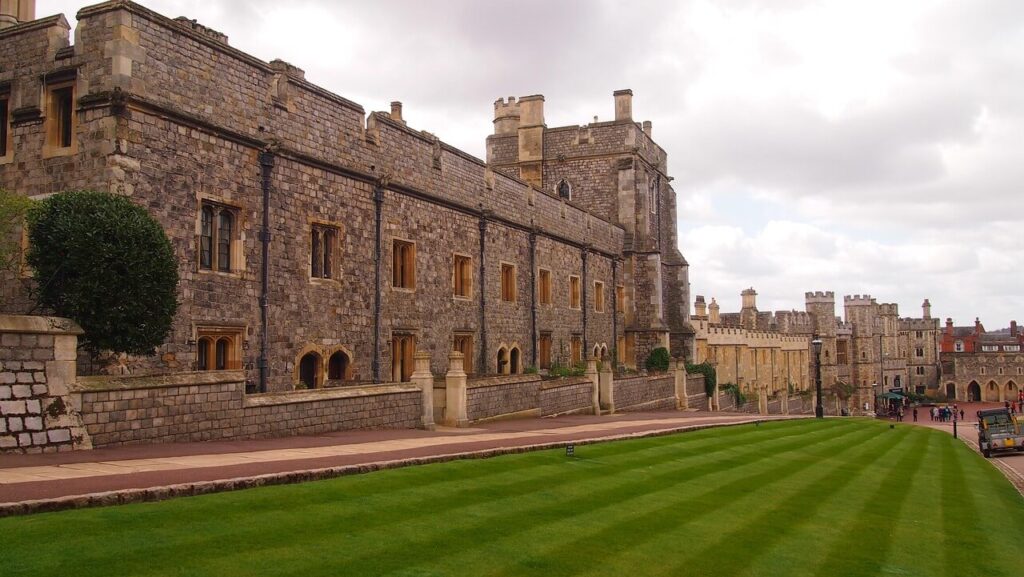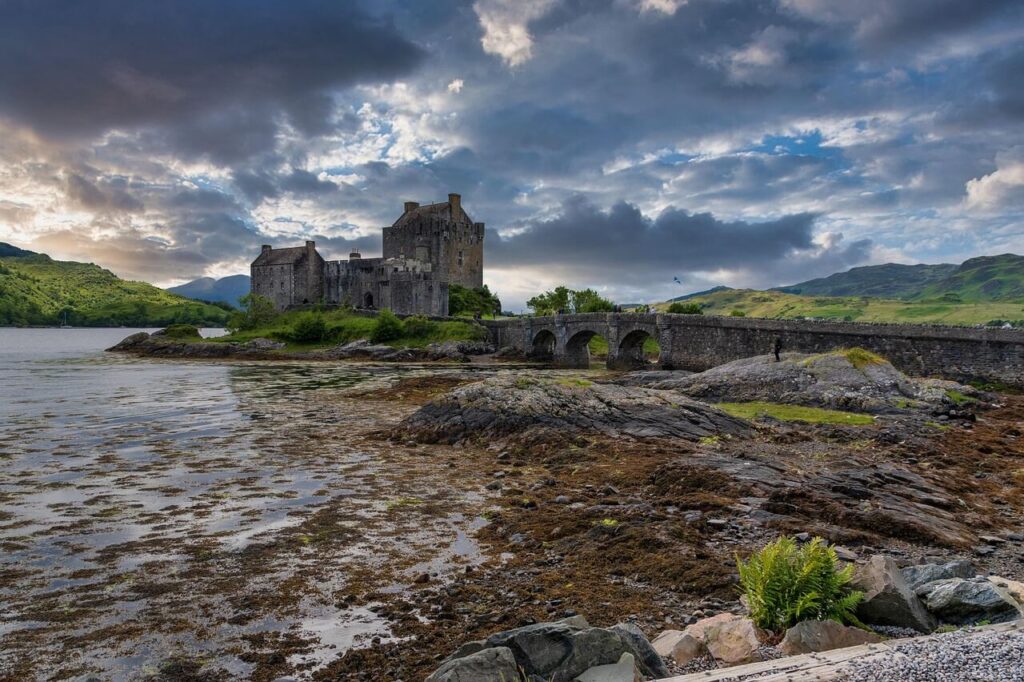The castles in Britain have a really interesting history. Some are famous, while others are less known. They are really important to the British because they are a huge part of the country’s history and culture. Most of the castles in Britain were built in the Middle Ages during the Norman invasion. They were constructed for defence, power, and control—also to flex their architectural skills and show off their stone-stacking abilities.
You should definitely visit these castles if you’re in Britain. Some of them have incredible views; I guarantee you’re going to change your Instagram profile picture. Also, some of them are haunted, so if you’re into history and spooky stuff, you will definitely love them.
So now, I am going to tell you about the top 7 castles in Britain—their history and why they were built.
Before I begin, I want to mention that I am sharing all of this from my own experience.
1. Edinburgh Castle (Scotland)
Some people say this castle is haunted, so if you believe in ghosts, I am sorry—but if you like it, this castle is the best for you. Edinburgh Castle sits on Castle Rock, a volcanic plug formed over 350 million years ago, making it impossible to attack except from the east. This castle was also attacked 23 times, making it one of the most besieged places in Europe.
This castle also played a key role in the Scottish independence war from 1296 to 1356. It was built around 1130 and is still used for weddings today. The reason why this castle was built was mainly for military defence.
Also, did you know that this castle was stolen by King Edward I of England in 1296? But it was returned in 1996. The English must have felt bad for the Scottish after 700 years. Mary Queen gave birth to a child—he was King James VI.
This castle was a royal prison. It held prisoners like the French prisoners in the Napoleonic Wars and American prisoners—also pirates. This castle was also a home to an elephant once, in the 1830s at the 78th Highlanders.
This castle also inspired the Harry Potter series. J.K. Rowling, when she was living in Edinburgh, used the castle as inspiration for Hogwarts. Ever since 1861, this castle fires a cannon every day at exactly 1 PM, except Sundays.
Visiting Info:
If you want to visit this castle, just remember on the weekend it gets really crowded. This is also Scotland’s most visited place. This castle welcomes over 2 million visitors every year. It is open every day except Sundays and Christmas.
Opening hours: 9:30 AM to 5 PM
Prices:
- Adults 16+: £19.50 online / £22 at the door
- Children 11–15: £11.40 online / £13.20 at the door
- Children under 5: Free
Location: Castlehill, Edinburgh EH1 2NG, UK

2. Windsor Castle (England)
This castle was built in 1070 after the Normans’ invasion. It was built by William the Conqueror. This castle served as the royal residence for over 900 years. Queen Elizabeth used to spend quality time here, especially in her late years. Queen Victoria and Prince Albert really liked it in this castle. After Prince Albert passed away, Queen Victoria spent much of her time in Windsor Castle.
Windsor Castle is the largest and oldest castle in the world. This castle is also used for royal weddings. Prince Harry and Meghan Markle got married here in 2018.
Windsor Castle survived the English Civil War from 1641 to 1651. It was seized by Parliamentarian forces and used as a prison for King Charles I before his execution in 1649. Some people say this castle is haunted—so basically, the royals get married in a haunted place!
It’s also my dream to get invited to a royal wedding. Windsor Castle has 1,000 rooms and 300 fireplaces, but sometimes I wonder if they have 300 teacups in this castle. Also, this castle has a railway connection—it was built in 1849. The main reason for building this was so that Queen Elizabeth could travel to the castle easier.
Visiting Info:
Open Thursday through Monday. Sometimes it can be closed due to events—do your research before going.
Prices:
- Adults: £35
- Young adults (18–24): £20
- Children (5–17): £15.50
Location: Windsor SL4 1NJ, UK
3. Cardiff Castle (Wales)
Cardiff Castle is over 2,000 years old. This castle was built in 50 AD and was originally constructed as a Roman fort. The remains of the fort can still be seen today. This castle played a huge role in World War II during the German bombing, where 2,000 people took shelter in the tunnels. You can still see the tunnels today.
Another interesting thing about Cardiff Castle is that it’s home to peacocks—they freely roam around the castle. People also say that this castle is haunted. In addition to its history, Cardiff Castle also hosts concerts, festivals, and events.
Visiting Info:
Open daily from 10 AM to 4 PM (9 AM to 6 PM in summer).
Prices:
- Adults: £15
- Children (5–17): £11
- Family ticket (2 adults + 2 kids): £45
- Free for Cardiff residents with a Castle Key Card
Location: Castle St, Cardiff CF10 3RB, Wales
Things to Do:
- Climb to the top of the castle for the view
- See the luxurious, gold-adorned rooms by William Burges
- Walk through the WWII tunnels
- Watch the peacocks
- Explore gift shops and cafés

4. Tower of London (England)
This tower was built by William the Conqueror in 1066. This tower is almost 1,000 years old. When it was first made, it was designed to be a fortress and a royal palace. But over time, it became a prison, an execution site, and a treasury.
The second wife of King Henry VIII was executed in this castle. Her name was Anne Boleyn. She was executed in the Tower of London because she did not give birth to a male heir, but Henry VIII accused her of adultery—basically, he lied. She was executed in 1536. The last person executed here was a German spy named Josef Jakob in 1941 during World War II.
This tower was once a zoo in the 13th century. It had animals like lions, polar bears, and even an elephant. These animals were gifted by foreign rulers. The zookeepers gave the polar bear a big leash so it could fish in the River Thames.
This tower has expensive jewellery collections protected by armed guards 24/7. It includes the Koh-i-Noor diamond, which some believe is cursed! This castle also has ravens. People say that if the ravens are gone, the kingdom will fall. They always keep an extra raven in case something happens to the other one.
Visiting Info:
Open daily from 9 AM to 4:30 PM.
Prices:
- Adults: £35.80
- Children (5–15): £17.90
- Ages 16–17: £17.90
- Children under 5: Free
Location: London EC3N 4AB, UK
5. Stirling Castle (Scotland)
The Stirling Castle was built by James IV, James V, and James VI in the 16th century. This castle is still in use today. This place wasn’t just for the royals to live—kings and queens used to hold elaborate banquets, feasts, and even jousting tournaments within its walls.
When Mary Queen of Scots was a child, she used to play in the garden of this castle. She used to sneak away from her duties and spend time with her ladies in the royal grounds. She spent most of her childhood in this castle.
The Stirling Castle isn’t just for defence—they have really cool design features. For example, the castle’s “Great Hall” has a ceiling so high it was once believed to be a form of atmospheric defence. The idea was that any attackers would feel dwarfed by the towering space inside.
Visiting Info:
Open from 1 April to 30 September, 9 AM to 6 PM.
Closed on Christmas.
Prices:
- Adults: £17.50
- Concessions: £14
- Children: £10.50
6. Durham Castle (England)
This castle was built by the Normans. Durham Castle was constructed in the 11th century following their conquest of England. It was built on the orders of William the Conqueror to help control the north of England.
Durham Castle has amazing architecture—it’s worth visiting. This castle is also known as the home of the Bishops of Durham. The bishops were powerful figures in medieval England, holding both religious and political influence.
Since 1837, Durham Castle has been used as part of Durham University. Students live in rooms within the castle, so it’s not just a historical monument but also a “real” functioning castle with a university twist! Imagine doing your work surrounded by centuries of history.
Some people say this castle is ghosted (the Grey Lady ghost), particularly in the areas around the Great Hall. Some people have claimed to see her roaming the halls. This castle has the best view (my opinion). King Charles I stayed in Durham Castle in 1646, just before the English Civil War kicked into full swing. He took refuge in the castle after being defeated by Parliament forces.

7. Eilean Donan Castle (Scotland)
This castle was built in the 13th century by Alexander II (my personal favourite castle). The name Eilean Donan means “Island of Donan”—it was named after Saint Donnán, a 7th-century Celtic saint.
Over the centuries, the castle became the stronghold of Clan MacKenzie and their allies, Clan MacRae. They played a significant role in Scotland’s history. During the Jacobite uprisings in 1719, this castle was destroyed after British navy ships attacked it. This attack was led by a Spanish garrison supporting the Jacobites. They blew it up with gunpowder after attacking it.
In the 20th century, Lieutenant Colonel John MacRae-Gilstrap wanted to rebuild the castle—so he did. He and his team carefully restored Eilean Donan to its former medieval glory from 1919 to 1932.
Eilean Donan Castle was used in films such as Highlander (1986), James Bond: The World Is Not Enough (1999), and Made of Honor (2008).
Visiting Info:
Open from February to December, 10 AM to 6 PM. Closed in January.
Prices:
- Adults: £11
- Children over 5: £6.50
- Children under 5: Free
Tips for Visiting Castles in Britain
The best time to visit castles in Britain is late spring to early autumn. If you want fewer crowds, pleasant temperatures, and beautiful gardens, then the best time for you is May to June. But if you want to go in the summer, be careful—it’s a peak tourist season with high crowds and the warmest weather.
Famous castles like Windsor and Edinburgh are especially busy. I went to most of these castles in September and there were fewer tourists and still warm temperatures, making it a quieter visit.
If you want fewer crowds, then the best time is October to April, but some castles may have limited access.
More Tips:
- Some castles have uneven floors, so wear comfortable shoes.
- Britain’s weather is unpredictable—check the weather and wear appropriate clothing like a waterproof jacket or bring an umbrella, even in summer.
- If you’re visiting in winter, please wear layers, scarves, or gloves.
If you have visited any of these castles, please share with us—we would be so happy to read your experiences!
